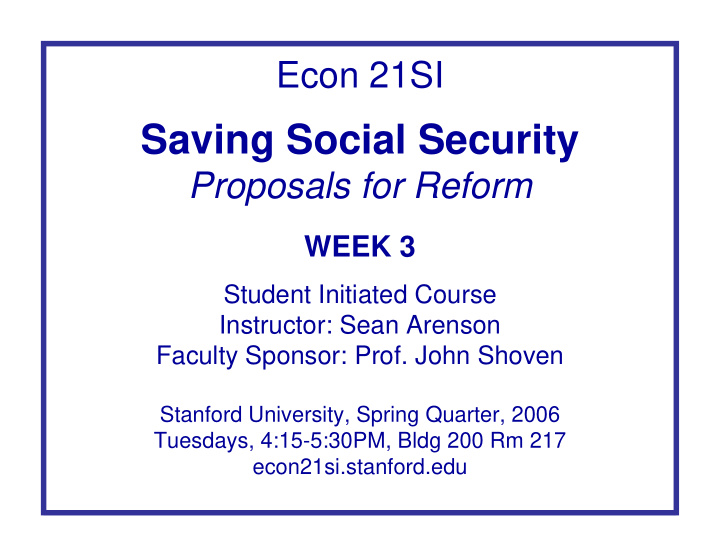



Econ 21SI Saving Social Security Proposals for Reform WEEK 3 Student Initiated Course Instructor: Sean Arenson Faculty Sponsor: Prof. John Shoven Stanford University, Spring Quarter, 2006 Tuesdays, 4:15-5:30PM, Bldg 200 Rm 217 econ21si.stanford.edu
In The News Universal Themes May 15, 2006 Report: Portugal Plans Pension Reforms “Workers with fewer than two children will have to contribute more to their government pensions under planned reforms to prevent the collapse of Portugal's retirement system…Contributions would stay unchanged for people with two children, decrease if they had more than two.” “A Portuguese pension is calculated as a percentage of the top-earning 10 years of the last 15 years of the recipient's working life. Under the reforms, the pension would be calculated according to the employee's entire working life.” “Some workers will be offered the choice of working beyond the current retirement age of 65 or increasing their pension contributions.” “The reforms seek to address a pension crisis being felt in several European Union countries due to a falling birth rate and increased life expectancy, as well as lavish payouts.” “Portugal's pension fund may be unable to meet payouts in 10 years. Portugal's birth rate has fallen to 1.5 children per family, down from 2.6 children per family three decades ago.”
In The News Personal Accounts May 15, 2006 Americans Unsure About Retirement Funding “Experts say retirees can safely spend about 4 percent of their assets each year, but a study…found that just one in 10 respondents knew that rate.” “36 percent of those surveyed believed retirees could spend up to 14 percent a year, and 40 percent didn't know what a safe spending rate would be.” “The telephone survey involved more than 1,000 working and retired adults 41 and older with at least $100,000 in investable assets”
Econ 21SI This Week • Personal Security Accounts 2005 • Hybrid Indexing • The Unified Budget and the Trust Fund
Menu of Options Types of Benefit Cuts 75 Years 2080 Replace Wage Indexing with Price 100% 116% Indexing Hybrid Indexing 72% 70% Index Retirement Age to life 25% 25% expectancy improvements Reduce Benefit formula gradually 85% 57% from 90,32,15 to 90,21,10
Menu of Options Types of Revenue Increases 75 Years 2080 Raise the OASDI Payroll Tax from 12.4% to 14.4% 104% 34% Raise the Payroll Tax Cutoff to $150,000 40% 14%
Proposals for Reform So far… • Diamond-Orszag • President’s Commission Model #2 • Discussion to come…
Proposals for Reform Personal Security Accounts 2005 • Two-tiered program • Current law revenue stays in tact • Tier 1 (DB) replaces traditional benefits with $600 flat monthly benefit indexed to wages (adequacy) • Tier 2 (DC) involves mandatory personal accounts funded by a 2.5% carve-out and a 2.5% add-on (equity) • Gradual transition – does not affect those over 55 and workers between 25 and 55 get a blend
Proposals for Reform Personal Security Accounts 2005
Proposals for Reform Personal Security Accounts 2005 • Index FRA to increases in life expectancy (after reaching 67 in 2011 • Index early retirement age to life expectancy until it reaches 65 • Universal coverage • 50% of PSA converted to inflation-adjusted annuity • Other 50% lump sum
Proposals for Reform Personal Security Accounts 2005 • One way of achieving flat benefits: Hybrid Indexing – AKA “Pozen Plan” or “Progressive Price Indexing”
Proposals for Reform Hybrid Indexing • Avg wages grow 1.1% faster than prices • Retirees in 40 years will receive 55% higher real benefits • Option #1: Switch to price indexing – 75 years: 100%, 76 th year: 116% • Problem: Represents large benefit cut for poor
Proposals for Reform Hybrid Indexing • Bottom 30% of AIME, benefits grow with wages • At max AIME, benefits grow with prices • In between, benefits partially indexed to prices and partially to wages • Result: Benefits for lowest earners grow 1.1%/year faster than highest earners. Eventually, all benefits equalize at current real benefit of highest earners
Proposals for Reform Hybrid Indexing • Benefit cut very gradual – 1%/year • Softens the blow on most vulnerable
Proposals for Reform Hybrid Indexing Hybrid Indexing Current Law
Proposals for Reform The Unified Budget • 1969 – US adopts unified budget • Counts net transaction between government and public including earmarked revenue and expenditures • 1983 – Move to pre-fund Social Security • Problem: Social Security surpluses counted in trust fund balance AND annual unified budget
Proposals for Reform The Unified Budget • Clinton era surpluses – debt still increasing! • How can there be a net positive flow of cash AND a net increase in debt? • Reality: There never was a true surplus. Surplus entirely due to trust fund
Proposals for Reform The Unified Budget
Proposals for Reform The Unified Budget • Should be “Trust Funds” budget and “Federal Funds” budget • Surpluses and accrued interest in trust funds go to Trust Funds budget • Interest to trust funds counted as expense to Federal Funds budget • Already done in every state
Proposals for Reform The Unified Budget • Currently, OASDI trust fund holds “assets” to Social Security – who’s liability? Future taxpayers.
Recommend
More recommend